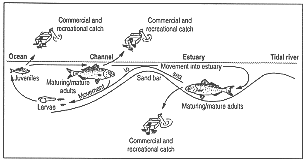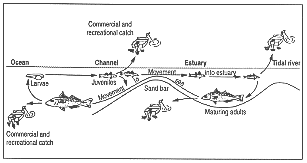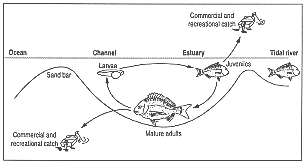
Figure 6-1: Feeding area for mature adults

Figure 6-2: Juvenile nursery area

Figure 6-3: Permanent breeding area
Fish

Figure 6-1: Feeding area for mature adults
Figure 6-2: Juvenile nursery area
Figure 6-3: Permanent breeding area |
These fish live and breed in the ocean. They come into estuaries to feed when they are maturing or mature adults. Most of these species are more commonly found in the ocean. When they come into an estuary they usually stay close to the estuary entrance where the salinity is like the ocean's.
Common species of these 'marine stragglers' include Australian herring and salmon, skipjack, blowfish, school whiting, scaly mackerel, and most of the sharks and rays.
Fish use estuaries and rivers as nurseries for juveniles. There is abundant food. Small fish can find protection and shelter from both predators and the more harsh marine environment. Shallow banks and seagrass meadows are the most important nursery habitats for these fish.
Common species in this group include mullets (sea and yelloweye), whitings (King George, western sand and trumpeter), silver bream, tailor, mulloway, some of the flatheads and flounders, sea garfish, striped perch (trumpeter), roach, whitebait and anchovy, and the commercial crustaceans the blue manna crab and king prawns. These fish include the bulk of the important commercial and amateur fishery species found in estuaries and rivers.
Fish in this group live the whole of their life cycle in estuaries and rivers and are adapted to their environmental conditions.
Common species in this group include black bream, cobbler, some flathead and flounder species, river garfish, yellowtailed grunter, hardy head, gobbleguts and some of the gobies. Some of these species can also reproduce and live outside the estuary in bays (also known as 'marine embayments').
The saltiness of the water affects how easily fish can move between an estuary and the sea. Fish which live all the time in an estuary or river have to be able to cope with big differences from season to season, especially in an estuary. These sorts of fish, which live easily in salty or fresh water, are known as euryhaline (meaning 'broad breath') species.
Fish which use estuaries and rivers as nurseries usually do so in summer when the salinity is close to sea water's. Some of these species are forced out into the ocean by the freshwater flush which occurs with the first winter rains. Others are able to cope with changing conditions and stay in the estuarine environment all year.
Fish from the sea which only enter a waterway occasionally to feed can usually only tolerate small decreases in salinity. Most only come into an estuary in summer when the water is saltiest. Fish which only live in water of the same salinity as seawater are called stenohaline: marine species (meaning 'narrow breath').
There are also freshwater fish which cannot tolerate changes in salinity. These fish are called stenohaline: freshwater species.
The temperatures in a waterway will affect where fish go. Falling winter water temperatures can often force fish out into the warmer oceanic waters. Shallow, semi-enclosed bays in a waterway may become warmer during warm weather or cooler during cool weather. Fish which normally live in these bays might have to leave during these temperature changes.
| For more information about this see section 4.4 - Parameter 4 |
Dissolved oxygen levels might decrease for a number of reasons, such as:
Low oxygen levels in water may be unacceptable to some fish and encourage them to move to another part of the estuary or river or into the open sea. Low oxygen levels may kill some fish. Oxygen levels below 5 mg/L can cause changes in behaviour, while levels below 3 mg/L can cause death.
Where fish go in a waterway can be affected by the turbidity of the water (how muddy or cloudy the water is), winter rains and strong river flow, and surface and bottom waters mixing. The turbidity of the water - particularly that caused by the winter flush, or by surface and bottom waters mixing over shallow banks owing to persistent strong winds - may affect the distribution of fish within a waterway. Fish generally tend to avoid turbid areas, because turbidity may cause their gills to clog and have a harmful effect on spawning and, egg and larvae development. Human activities such as dredging can make the turbidity and its harmful effects much greater.
Macroinvertebrate animals (such as worms and snails), which are eaten by many fish, are more abundant in the shallow banks than the deeper, muddy banks of a waterway. Fish, juveniles in particular, are also usually more abundant on the shallow banks where they can find and eat the macroinvertebrates easily.
Catching fish by fishers can have a big impact on fish communities. Despite more and more people catching fish, the fish population doesn't appear to have got any less over the last few years. This is because most of the fish and crustaceans that are caught come in from the ocean to the estuary each year. How many there are in a waterway one year doesn't have much to do with how many there will be the next year. However, different fish use different waterways from year to year. One type of fish might go to a different part of an estuary than the one it was in last year, for example. If all types of fish are caught in big numbers, then the total number of fish might be less.
Fisheries are protected by restricting the numbers and sizes of fish that are caught, and by looking after their habitats. Both amateur and professional fishers want to catch fish, sometimes the same sort. Plans have to be made to ensure that both groups can be satisfied and the quality and variety of fish is maintained. To do this, water quality must be good and habitats suitable for all stages of a fish's life must be protected. Strategies to protect fisheries are aimed at conservation of fish stocks and habitats.
There are many ways in which the commercial and recreational fisheries of a waterways environment can be protected:
By protecting habitats which are souces of food and shelter for fish, and protecting waterways from pollution and other damage, fish numbers will be maintained. To protect habitats and waterways, new developments (such as housing and industrial estates near waterways) need to be controlled. To do this, environmental impact assessments are done. Areas that are very important need to be declared high conservation areas and reserved from development and other damage.
There are regulations in the Fisheries Act 1905 (Amended) which restrict the size, number and time of year when fish and shellfish can be caught. The Act's regulations also permit commercial and amateur fishing licences to be issued for catching certain species. This protects the breeding stocks and ensures plenty of young fish come into the estuaries and rivers. People who don't obey the regulations are fined.
Education is a large part of protecting fisheries. Information can be given to commercial fishers and the general community about the need to obey regulations and protect the fishery. The aim of the education should be for people who catch fish to be responsible for protecting them, too.
The more people who look after waterways know about fish, the more able they are to protect fish. Information on how fish live, move between different parts of a waterway, and are affected by the environment in which they live influences how waterways managers look after the fish and the waterways.
Fisheries Western Australia is responsible for managing the fish resources in Western Australia for the benefit of the community. Legislation governing fishing in Western Australia is contained in:
Under the legislation the Minister for Fisheries and Fisheries Western Australia are responsible for the management of the professional and recreational fisheries of the waterways. Fisheries WA employs fisheries inspectors who enforce the regulations under the Act. Its officers also research fish species, often in conjunction with State Government departments or universities. Funding for research is usually supplied through the Fisheries Research and Development Fund.
Fisheries WA is also responsible for the approval of aquaculture activities. Fisheries WA has established the Inter-Departmental Committee on Aquaculture (IDCA) to enable concerns of State Government departments and agencies to be considered.